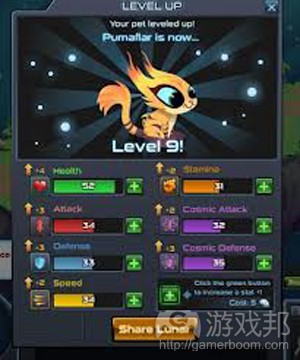阐述拯救社交游戏的4点设计建议
作者:Josh Bycer
几周前我发表了一篇有关消极游戏机制的文章:即关于一些可能会导致当前玩家离开游戏的机制设计。在那篇文章中我谈到了社交游戏是如何利用这些机制并因此大大破坏了游戏设计。
而让我郁闷的地方有两点。首先便是社交游戏设计师拒绝承认他们在使用这些机制而创造游戏。其次便是当前社交游戏的设计原理正在扼杀着那些原本非常出色的游戏理念。
在之前的文章中我以Insomniac Games的《Outernauts》为例进行说明。而今天我将分析Zynga的《Indiana Jones Adventure World》。
这是一个优秀的游戏理念,开发者加入了《夺宝奇兵》主角Indiana Jones的元素而设计出了这款“行动冒险游戏。”但是在玩了30分钟的游戏后,我却因为能量耗尽而不能继续前进。这时候我所面临的压力便是决定是否向好友发送垃圾邮件,以及如何面对游戏中不断弹出的各种道具的价格标签。
在明确了Facebook和Zynga所面临的问题时,我不禁怀疑社交游戏泡沫是否濒临爆破。而最糟糕的则是社交游戏设计中缺少足够的多样性。
但是不可否认的是社交游戏吸引了许多从未接触过游戏的玩家进入游戏世界。
尽管现在很多人都认为“社交游戏即将终结”,但是我将带着一种挑战精神在此阐述如何同时为硬核和非硬核玩家创造一款优秀的社交游戏。
1.让玩家自己决定游戏时间长短
社交游戏中最严重的一负面游戏机制便是行动资源:玩家只有在拥有足够的能量时才能在游戏中进行互动。但是这种机制不仅会破坏游戏玩法,同时也会干扰到好友。当你在任何一款社交游戏中用光能量时便会弹出一个告示,让你选择是否向好友求助而获得更多能量。而行动资源所存在的问题便在于它好像是专门用于惩罚那些想要更长时间玩游戏的玩家。强迫玩家在游戏中途莫名其妙停下脚步的机制真的很烦人。
而社交游戏中之所以会存在这种机制的一大原因便是强迫玩家要么花钱继续游戏,要么向好友发送求助信息。从设计角度来看另一个原因便是,大多数玩家都不希望连续玩好几个小时的游戏,特别是那些只玩社交游戏的“玩家”。所以使用了行动资源,设计师便无需担心玩家会在游戏中途感到无聊。但同时,设计师也不能在奖励某个群体而惩罚另一群体的情况下,指望游戏能够获得发展。
多年前任天堂和Popcap等开发者便想出了解决方法:设计出任何人都可以尝试的小关卡。基于较小的关卡,玩家便能够在更短的时间内前进,而资深玩家也能够同时挑战更多不同的关卡。基于不同玩家,游戏时间可能是短短的5分钟,也有可能是1小时。当游戏进程变得更加快速时,不管玩家是否愿意在游戏中继续前进,他们都不会受到其它系统的约束。而如果你坚持使用行动资源,那么下一个要点将带给你更多帮助。
2.将付费与玩游戏分割开来
在过去几年时间里设计师所掌握的基本规则便是,千万不要干扰玩家的游戏过程,除非真的非常必要。但是在社交游戏中,玩家却总是会被各种弹出窗口(游戏邦注:让他们向好友发送信息,购买更多道具或在推广墙上刊登游戏信息等)而干扰到游戏体验。
对于这一点,社交游戏设计师可以参考F2P游戏设计:为了确保任何机制的有效性,我们就必须将其隔离在游戏玩法之外。换句话说:付费界线不能越过游戏过程。如果你在游乐园中起着脚踏车,你是否愿意在中途停下来向所有人征集更多货币?
社交游戏总是会让玩家在游戏中途停下来购买更多能量或购买更多道具去完成任务。如果游戏是基于微交易模式,设计师就必须确保这种交易是出现在玩家。这么做将能让玩家更加专注于游戏玩法而不会去顾虑自己的钱包。
另外一个问题便是游戏过程中所弹出的要求玩家花钱的任务或内容。这种机制并不利于游戏玩法的发展,设计师应该想办法避免这种机制。
让我们再次回到行动资源问题上,这种方法将能够帮助设计师创造出更有意义的内容。即让行动资源变成是玩家进入某些游戏领域的“门票”,就像《军团要塞 2》中的“Mann vs. Machine”模式。这时候即使你的游戏设计是基于行动资源也不会妨碍游戏的发展。而创造出更有意义的行动资源也将我们引向了下一个要点。
3.提供真正有价值的付费内容
在电子游戏中花钱是件大事,不容轻易被忽视。但是当你开始要求玩家为游戏掏腰包时,你也必须确保玩家不会有被剥削的感觉。
不管是免费游戏,在线服务还是社交游戏都在利用付费资源:即玩家必须通过花费现金才能获得的资源。而这种资源的作用便是能够购得独特的内容。社交游戏中所存在的问题则是玩家可以使用付费资源换得所有游戏内容——这便大大削弱了付费资源的价值。
当面对的是免费游戏时,设计师便需要想办法创造出值得玩家花钱的内容。就像在《英雄联盟》中,玩家可以购买全新的角色皮肤而改变角色的外貌,有时候他们也可以购买自己喜欢的音效。
关键就在于当你要求玩家支付额外的费用时,你必须向他们保证所有的支出都是有价值的。不管对象是独特的游戏玩法还是身份象征,如角色的皮肤。有些情况下,当一款游戏非常出色时,玩家便会主动购买付费内容而支持开发者所创造的免费游戏——这时候你便会意识到设计师的坚持是有成效的。
我希望社交游戏设计师能够明白,当你让玩家通过花钱而完成任务或略过某些关卡时,这只能说明你所创造的是一款糟糕的游戏,让玩家宁愿花钱也不想耐着性子玩游戏。
你不能让玩家为他们凭借自己的努力就能得到的资源付费。如果你希望玩家愿意玩你的游戏并为游戏花钱,你就必须让他们感受到自己的支出是有价值的。而不只是用于略过某些内容或完成任务。
如今许多免费游戏和常规游戏都突出了微交易,即基于竞争环境而更好地完善玩家的行动。这便将我们带进了“花钱获胜”领域,并且在某些游戏中还存在。而因为我们在此所谈论的是社交游戏,所以我将有针对性地进行分析。
如果你的游戏拥有足够的内容能够满足所有玩家,你便可以基于一定的价格推出带有额外任务或内容的“补充包”。让玩家花钱获得更多任务的设置当然会热闹某些群组的玩家,但是如果这是你的游戏中的唯一一种交易模式,结果便不会太糟糕。
4.重新赋予游戏社交性
我想要强调的最后一点便是让玩家能够在社交游戏中彼此互动。我并不是指带有竞争性的赌场类游戏,而是指那些具有更复杂游戏玩法的游戏。
尽管标题中带有“社交”两字,大多数社交游戏却不是建立在玩家互动的基础上。尽管玩家能够访问好友的领域或向他们请求道具,但是这却不是真正的交流与合作。有些游戏让玩家能够邀请好友的角色进入游戏,但是这些角色却受到AI的控制而非好友。
虽然许多社交游戏都是汲取其它游戏的灵感,但是我却很惊讶的发现没有一位设计师看到了《Puzzle Pirates》的优势。在《Puzzle Pirates》中,一群玩家将扮演一艘轮船上的船员,并且每个人都将执行不同的任务。这些任务将转变成不同的益智游戏,而每个玩家在益智游戏中所获得的分数将推动着这艘船的航行。
我不能理解为何没有一位社交游戏设计师采用这种游戏理念,在我看来这是最适合社交游戏设计的理念。即创造出让玩家们能够协力合作,并且一群好友能够通过共同努力而获得功能奖励的简单的游戏系统。我们可以将其当成是小型的MMO游戏,在确保不会出现过度挑战性的同时保留玩家间相互合作的理念。
不管是社交游戏还是手机游戏市场都不再处于发展初期,现在开发者需要做的便是使用新理念去发展各自的市场。手机游戏开发者便做到了这一点,因为我们可以看到各种不同类型和难度的游戏相继涌现出来。但是社交游戏市场似乎还未迈出这一步。似乎我们现在所看到的新的社交游戏仍在沿用之前的设计理念。如果社交游戏产业希望得到其他设计师和玩家的尊重,它们便需要赶紧采取相应措施了!
(本文为游戏邦/gamerboom.com编译,拒绝任何不保留版权的转载,如需转载请联系:游戏邦)
Advancing Social Games
By Josh Bycer
A few weeks ago I posted a look at negative game mechanics which were: mechanics designed to stop the current player from playing the game. In that post I talked about how social games are making use of them and that it is stifling the game design in them.
What is frustrating to me is twofold. First is the denial or delusion of social game designers that they are making unique products by using these mechanics. And second is that the current design philosophy behind social games to me is killing what could be great ideas.
In the last post on this subject I mentioned the social game Outernauts: a Sci-Fi take on Pokémon developed by Insomniac Games. This week I tried Indiana Jones Adventure World by Zynga after watching the GDC presentation on it.
The concept of the game was a good idea, and I could see the merits of designing an “action-adventure game light” using the Indiana Jones property. But after about 30 minutes of playtime, split between three sessions due to running out of energy, I had enough. Between the constant pressures to spam my friends to play and all the price tags popping up with every item got to the point of aggravation.
With the problems facing both Facebook and Zynga I can’t help but feel that the social game bubble is close to bursting. Not helping matters is the lack of variety in design between social games.
But I still see promise with social games as a way of getting people who didn’t grow up playing games, into them. Now it would be easy to just say that “social games are going to die” and let that be the end of it. But I’m in the mood for a challenge and for this post; I’m going to try to create guidelines to make a social game that can work for both soft and hardcore audiences.
1. Let the player play for as long or as short as they want.
One of the most prominent negative game mechanics in social games are action resources: where the player can only interact in the game when they have enough energy. This mechanic not only becomes a determent to the gameplay, but is also used to bug your friends. The first thing that pops up when you run out energy in any social game is the option to ask your friends to do something to get your more energy.
The problem with action resources as they stand is that they are designed to punish people who want to play for a long period of time. It’s annoying to play through a map, or a stage and have to stop half way through not by the player’s choice.
One of the reasons why social games are designed this way is to force the player to either spend money, or spam their friends with requests. Another reason in terms of design is that most people don’t want to play for hours on end, especially the main audience of social games which are non gamers. And with action resources, it allows the designer to not worry about their audience playing the game to the point of boredom. But at the same time, you can’t reward one group and punish the other and expect your game to grow.
Developers like Nintendo and Popcap have figured out the solution years ago: design bite sized levels that anyone can play. With short focused levels, it will let people make progress in a short time, while expert players can sit and play through multiple levels at one time. Depending on the person, a play session may only last 5 minutes, or an hour. By keeping progression quick, it allows anyone regardless of their preference to make progress in the game, without being tethered to another system.
Now, if you are adamant about having action resources and want to include them, then this next point is for you.
2. Keep pay and play separate:
One of the basic rules designers have learned over the years is to not interrupt gameplay unless it is vitally important. But in social games, the player is constantly being taken out of the experience by pop-ups asking them to message their friends, buy more stuff or post an achievement.
For this point, social game designers need to learn a lesson that F2P games have already learn: for pay mechanics to work, they must be kept out of the gameplay. To put it another way: the pay barrier cannot be intertwined with playing the game. If you’re going on a ride at an amusement park, does the ride stop halfway through to collect more money from everyone?
One element that I see in social games is the game stopping the player to either buy more energy or buy more items to complete a quest. If the game is based on micro transactions, then they should occur before or after actually playing the game content. This would allow people to focus on the gameplay instead of their wallets.
Another part of this is having quests or content pop up during play that requires the player to spend money. Once again these gating mechanics are not beneficial to the gameplay and should be avoided.
Going back to action resources, this would allow the designer to make them more meaningful. Have them act as tickets for playing areas, similar to the Mann up tickets in Team Fortress 2′s Mann vs. Machine mode. That way if your design is built on action resources, they would not interrupt the flow of the game. Making action resources meaningful brings us to my next point.
3. Making money matter:
Spending money in any video game is a big deal and should not be taken lightly. When you start asking the player to keep putting money into a game, the designer has to make sure that the player doesn’t feel like they’re being ripped off.
Free to play games, online services and social games all make use of premium resources: resources that can only be earned by spending real cash. This type of resource is primarily used to buy unique content. The problem with social games is that they make everything purchasable with premium resources and dilutes their value.
When you play a free to play title the designers know that they need to make something worth it to spend money on. In League of Legends, players can buy new character skins that completely change the look of their character and in some cases the sound effects.
The point is that when you’re asking the player to spend additional money, and then there should be something that is really worth it. Either in the form of unique gameplay or simply as a status symbol such as the character skin example. There are cases where if the game is good enough, some people may be compelled to buy premium content to support the developers for the free game, when that happens you know that the designers are on to something.
I’m going to say the following as nicely as I can to the social designers who are reading this. When you have the option to complete quests or skip sections by letting the player spend money. What you’re telling me is that your game is so horrible that there isn’t any point in playing and instead just pay more money.
You should not have the only reason to spend premium resources be things that the player will accomplish on their own. If you want actual gamers to play your game and spend money, then you have to give them actual value for their money. Not just skipping through content or completing quests.
Now, many free to play and even regular games feature micro transactions that can improve the player in a competitive setting. This takes us into the realm of “pay 2 win” and something that needs to be watched out for in any game. But since we’re focusing on social games at the moment, I’m going to put talking about this to the side for this post.
If you title has enough content to satisfy your audience, one option is to release “booster packs” of additional quests or content for additional cost. Granted you are going to annoy some groups of people for charging for more quests, but depending on if it’s the only transaction model in your game, then it won’t be so bad.
4. Putting the social back in social game.
My last point and one that is disturbing that we haven’t seen yet, is allowing people to actually play with each other in social game. This point is not talking about casino styled games as they already have the competitive aspect down, but for games with more complex gameplay.
For a genre that has the word social in the title, most social games are not built around human interaction. Sure you can visit a friend’s area or bug them for items, but there is no communication or cooperation present. Some games let you invite your friend’s character into your game, but the character would be controlled by the AI and not by the friend.
Considering how many social games are inspired by other games and each other, I’m really shocked that no one has looked at the Puzzle Pirates method. In Puzzle Pirates, groups of players act as crew on a ship with each person performing a different task. The task itself is translated into a puzzle game, with how high each player scores at their task helps the ship at sea.
Why no social designer has thought about taking this idea further is beyond me as it is the perfect fit for social game design. Create simple game systems designed to work in tandem and let a group of friends play together for a shared reward. Think of it as a smaller scale version of a MMO raid, granted it won’t be anywhere as challenging but the concept of working together is there.
Both the social and mobile game markets are no longer considered in their infancy and now it is up to the developers to grow their respective markets with new ideas. Mobile games have been doing just that, with a wide variety of genres and complexity. But we have yet to see the social game market take such a step. With every new social game, adhering to the same designs as before. If the social game industry wants to be treated with respect both from other designers and gamers, then they need to start making waves before it’s too late.(source:chronicgamedesigner)










































 闽公网安备35020302001549号
闽公网安备35020302001549号